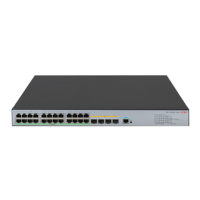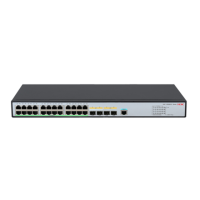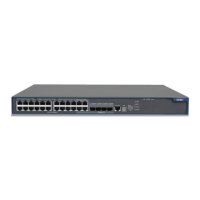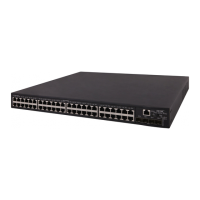4
• Local MAC—MAC entries dynamically learned from the local site. The outgoing interfaces for
the MAC address entries are site-facing interfaces. VXLAN does not support static local-MAC
entries.
• Remote MAC—MAC entries learned from a remote site. The outgoing interfaces for the MAC
address entries are VXLAN tunnel interfaces.
{ Static—Manually added MAC entries.
{ Dynamic—MAC entries learned in the data plane from incoming traffic on VXLAN tunnels.
The learned MAC addresses are contained in the inner Ethernet header.
For a MAC address, the manual static entry has higher priority than the dynamic entry.
Traffic forwarding
The device performs Layer 2 or Layer 3 forwarding for VXLANs depending on your configuration.
• In Layer 3 forwarding mode, the device uses the ARP or ND table to forward traffic for VXLANs.
• In Layer 2 forwarding mode, the device uses the MAC address table to forward traffic for
VXLANs.
Use Layer 3 forwarding mode if you want to use the device as a VXLAN IP gateway.
This section describes the Layer 2 forwarding processes. For information about Layer 3 forwarding,
see "Configuring VXLAN IP gateways."
A
VTEP uses the following processes to forward traffic at Layer 2:
• Unicast process—Applies to destination-known unicast traffic.
• Flood process—Applies to multicast, broadcast, and unknown unicast traffic.
When the VTEP forwards VXLAN traffic, it processes the 802.1Q tag in the inner Ethernet header
depending on the VSI access mode (VLAN or Ethernet mode). In VLAN access mode, sites can use
different VLANs to provide the same service. For more information, see "Access mode of VSIs."
Unicast
The following process (see Figure 4) applies to a known unicast frame between sites:
1. The source VTEP encapsulates the Ethernet frame in the VXLAN/UDP/IP header.
In the outer IP header, the source IP address is the source VTEP's VXLAN tunnel source IP
address. The destination IP address is the VXLAN tunnel destination IP address.
2. The source VTEP forwards the encapsulated packet out of the outgoing VXLAN tunnel
interface found in the VSI's MAC address table.
3. The intermediate transport devices (P devices) forward the frame to the destination VTEP by
using the outer IP header.
4. The destination VTEP removes the headers on top of the inner Ethernet frame. It then performs
MAC address table lookup in the VXLAN's VSI to forward the frame out of the matching
outgoing interface.

